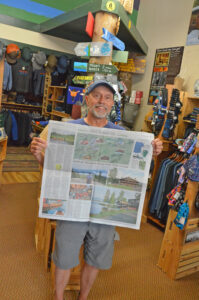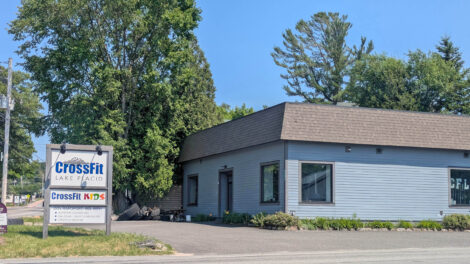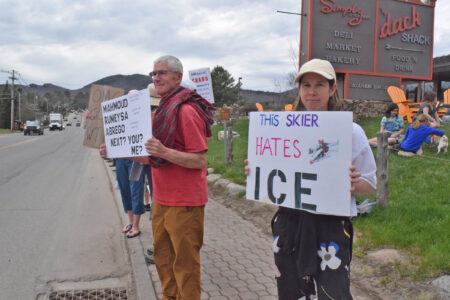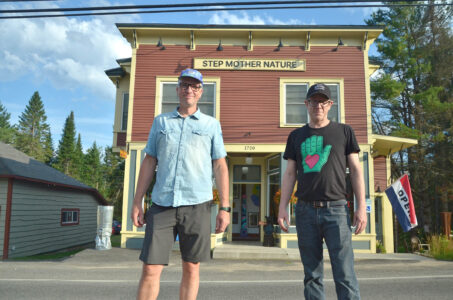Saranac Lake residents debate turf field at high school ahead of vote
Saranac Lake residents debate turf field at high school ahead of vote
- Saranac Lake High School student and track athlete Elijah Schenk speaks about the benefits he sees in SLHS installing an artificial turf field on Thursday. The potential field will be up for a public vote on May 21. (Enterprise photo — Aaron Marbone)
- Joy Cranker speaks on concerns about chemicals in a proposed artificial turf field at the Saranac Lake High School on Thursday. The potential field will be up for a public vote on May 21. (Enterprise photo — Aaron Marbone)
- Chris Knight speaks about the benefits he sees in the Saranac Lake High School installing an artificial turf field on Thursday. The potential field will be up for a public vote on May 21. (Enterprise photo — Aaron Marbone)

Saranac Lake High School student and track athlete Elijah Schenk speaks about the benefits he sees in SLHS installing an artificial turf field on Thursday. The potential field will be up for a public vote on May 21. (Enterprise photo — Aaron Marbone)
SARANAC LAKE — A proposition on the Saranac Lake school ballot on installing a turf athletics field at the high school has spawned a lot of conversation and debate ahead of a vote coming up on May 21.
On Wednesday, numerous members of the public spoke in support and in opposition of the proposed turf project at a public hearing with the school board. It was already being debated in letters to the editor in the Enterprise, online and in conversations around town.
Supporters say a turf field would be a boon for young athletes, extending their abilities to practice and play outdoors in the spring and fall, increasing the use of the field by more teams, reducing maintenance and providing an overall better playing space.
Opponents have health and environmental concerns about turf, which can contain PFAS “forever chemicals” with numerous health risks, and are known for causing more injuries in professional sports.
The issue is a complex one.

Joy Cranker speaks on concerns about chemicals in a proposed artificial turf field at the Saranac Lake High School on Thursday. The potential field will be up for a public vote on May 21. (Enterprise photo — Aaron Marbone)
“This is more people than we’ve had in years and years and years at our public hearings,” Saranac Lake Central School District Superintendent Diane Fox said on Wednesday.
–
The propositions and prices
–
Proposition 3 would authorize the district to convert the grass athletic field at the high school — inside the new track between the building and state Route 3 — into an artificial turf field with lights and a scoreboard. It would be used for soccer, lacrosse, football and flag football games, as well as outdoor practice space for other teams.

Chris Knight speaks about the benefits he sees in the Saranac Lake High School installing an artificial turf field on Thursday. The potential field will be up for a public vote on May 21. (Enterprise photo — Aaron Marbone)
This project would not increase taxes, Fox said.
The total estimated cost of the project could not exceed $4 million, according to the proposition. The project will use $2.8 million of the district’s $3.8 million Capital Reserve Fund — a construction fund for borrowing money — along with $397,563 in additional capital funds.
Fox said state aid would offset the cost of borrowing, leaving no local taxpayer impact. She said the district would get a 6.5% interest rate on a $782,000 bond.
If approved, Fox said the project could be complete by the fall of 2025.
Proposition 4, which would install bleachers and a press box at the turf field, could only be approved if Proposition 3 is approved. Though this proposition would include a cost to taxpayers, it was much less controversial.
The total estimated cost of the project could not exceed $1,250,000, according to the proposition.
Voting to approve it would authorize the district to take out a $1.25 million loan to be paid off over 15 years.
Fox said this would have an $8 per year impact for someone who owns a $200,000 home in the district. Property owners with STAR exemptions would have a $7 impact and those with senior exemptions would have a $4 impact.
Fox said her husband asked her “How the heck can bleachers cost $1.25 million?” The majority of the cost — $823,000 — is for the bleachers themselves, which she described as a “big box of steel.” Steel has been at high prices since the pandemic.
Fox said they chose to not put the turf and lights at the Wilson-Raymond Field at the nearby Petrova School because that property is in a neighborhood and because the high school has better parking.
Fox also said they chose to not move the bleachers from Wilson-Raymond field because the cost would be around the same as building new, and while those bleachers have been grandfathered in to new regulations, if they moved them, that could become an issue.
The Wilson-Raymond field would be used for baseball games, as well as the “home field” practice space for modified sport, which is not allowed currently. She also said the village shares a deed with the district for Wilson-Raymond field.
–
Artificial advantage
–
Artificial turf does not get muddied or need “rest” time like grass, meaning they can get more play time. Fox said lighting and artificial turf would provide three times the potential play time as grass with no lights.
Fox also said sports advocacy group have brought concerns about field equity, that some teams did not get as much access to fields. She said more play time on artificial turf would bring equity.
While natural grass takes a lot more maintenance, artificial turf needs to be replaced approximately every 15 years, at a price of around $750,000, according to Fox.
Lighting would allow for evening games.
Fox said 60% of SLCSD middle and high school students participate in a least one sport.
“The students here will not be using this field. We’ll all be graduated by that time,” SLHS junior Sam Clark said, adding that they have “no bias” because of this.
A baseball player, Clark said his team’s first game of this season was their first time on a field all season. They have been practicing indoors. He felt this puts them at a slight disadvantage compared to other schools.
Elijah Schenk, a track athlete, said they feel they are at a disadvantage against other schools because their training is limited by their field. He said the school also has strong focus on academics and other extracurriculars.
Clark also said the running track has no seating currently, which make it inaccessible to many people. He said bleachers would allow all family members to view athletics.
Fox said 55% of schools they compete against in Section 7 and 10 sports have turf fields.
–
Health, environmental concerns
–
“The turf industry is not regulated,” resident Joy Cranker said.
She said manufacturers sometimes lie about the presence of chemicals including PFAS in their product.
Cranker cited reports of professional football associations asking the NFL to move away from turf, the city of Boston banning turf over concerns it contains PFAS with similar efforts in Philadelphia, MLB moving away from turf and smaller communities feeling “buyer’s regret” and moving back to grass.
She has concerns about chemicals leaching into the local watershed.
“I would rather see the money going to something making the school more green than more toxic,” Cranker said.
An April 2024 study by the U.S. Environmental Protection Agency Fox cited found that synthetic turf did not pose an increased health risk because these chemicals are found in many other products people use daily.
Mark Wilson said the EPA study was a “pilot study” with a limited scope, and is not conclusive.
On Thursday, SLCSD board member Joe Henderson, who also teaches at Paul Smith’s College with a focus on sociology and environmental studies, said he feels the science shows a minimal impact on human health, because of all other other ways humans are affected by industrial pollution, but potential environmental harms.
Artificial turf is a “big plastic product” made from petroleum, he said, but its environmental impacts, especially the relatively recent discovery of PFAS is not well studied and inconclusive.
He did point out that the EPA study cites a study by the European Union, which he puts more credit into because the EU is usually more precautionary on environmental assessments of products than the U.S., which is more reactionary.
He also noted that New York’s Carpet Collection Program Law, which passed last year, will ban the sale of turf containing PFAS starting at the end of 2026.
In any case, Henderson said he hopes the product the district might use would not contain PFAS.
Wilson said PFAS are inherent in the manufacturing of turf and are biocumulative, meaning they do not degrade over time and collect in natural beings and environments. He is particularly concerned about the rare and impressive sandhill cranes which roost and mate in the fields of that area.
Fox said they would need permits from the Adirondack Park Agency, which would assess and regulate the environmental impact of the field, and that the APA is aware of project already.
Wilson said the pond next to the field is a Class 1 wetlands under the APA, the most sensitive designation.
Chris Knight, president of the Saranac Lake Youth Baseball and Softball Association and father of three kids, said there’s already lots of turf in the North Country, citing Beekmantown, Northeastern Clinton, Plattsburgh, St. Law Central, Massena and Potsdam. He said AuSable Valley is renewing its turf field after 18 years.
Knight added that these district’s taxpayers are paying for these fields, while SLCSD’s plan would have “minimum cost to taxpayers.”
Knight said the field would not take away from academics. He said the current athletics facilities are “deficient” with decades since the last major investment.
SLCSD board President Mark Farmer said most studies on turf versus grass injuries have been on professional athletes, which skews the results for high school comparisons. Schools do not have professional-level fields, and that thin grass, mud and uneven surfaces are probably more of a danger.
“As a father, I am 100% comfortable,” head football coach and former athletic director Eric Bennett said of a turf field.
Saranac Lake athletes are already traveling to other schools to play on their turf fields, Bennett pointed out, so if there is a safety problem or concern, he said they would have heard about it.
He said muddy fields are dangerous to play on.
“It’s like playing in soup,” Bennett said. “I think we can all agree that there’s probably no worse weather in the lower 48 (states) than the Tri-Lakes region.”
He said he sees teams’ records improve once they get practice time outside, and that turf would “level the field” and give them more opportunity.
Henderson said his son plays soccer.
“After reviewing the research, I’d let him play on the turf field,” Henderson said.
John Muldowney said many other districts have done their due diligence in researching turf before installing it at their schools, as well as the SLCSD board. He also advocated for the bleachers proposition, saying it is better to finish the project instead of doing a “half-measure.”
St. Armand town Supervisor Davina Thurston had one big question: “Where is the snack shack?”
It takes a lot to feed high schoolers, she said.
This led to a discussion about food, restrooms and accessibility. Fox said the district would open the high school up for bathrooms and might be considering some sort of concessions in the high school auditorium entrance.
With the turf issue being so controversial, Henderson said he’s glad it will be up to the public to decide in a democratic vote.
The SLCSD school board election, proposition and budget vote will take place from 7 a.m. to 8 p.m. on May 21 in the district offices near the auditorium at door No. 5 of the School at 79 Canaras Ave.







